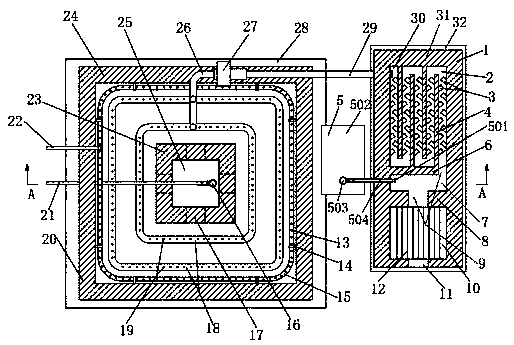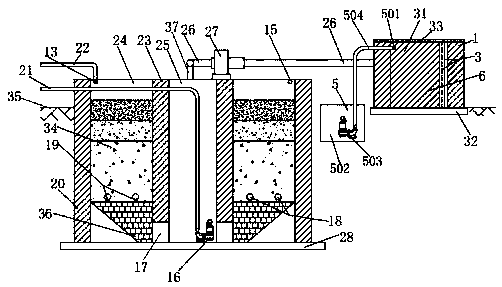Method and device for treating artificial wetland plant residues
A plant residue and artificial wetland technology, which is applied in the field of artificial wetland plant residue treatment, can solve the problem that wetland plant residue cannot be properly disposed of, and achieve the effect of resource utilization, turning waste into treasure, and reasonable treatment
- Summary
- Abstract
- Description
- Claims
- Application Information
AI Technical Summary
Problems solved by technology
Method used
Image
Examples
Embodiment Construction
[0024] The technical solutions of the present invention will be further described below through specific embodiments and in conjunction with the accompanying drawings.
[0025] Such as Figure 1-2 As shown, the device for treating plant residues in constructed wetlands includes a desulfurization and cooling incinerator 31 and a smoke elimination filter 24 .
[0026] Wherein, the desulfurization and cooling incinerator 31 includes a furnace base 32 whose upper surface is flat with the ground 35, a horizontal straight quadrangular columnar furnace wall 1 fixed on the furnace base 32, and a cover covering the top of the furnace wall 1. board 33, the interior of the furnace wall 1 is divided by the incineration chamber wall 8 and the desulfurization chamber wall 6 to form an incineration chamber 10, a desulfurization chamber 7 and a cooling chamber 2 in sequence, and the incineration chamber 10 is set on one side of the furnace wall 1 There is a feed port 11, and the desulfurizat...
PUM
 Login to View More
Login to View More Abstract
Description
Claims
Application Information
 Login to View More
Login to View More - Generate Ideas
- Intellectual Property
- Life Sciences
- Materials
- Tech Scout
- Unparalleled Data Quality
- Higher Quality Content
- 60% Fewer Hallucinations
Browse by: Latest US Patents, China's latest patents, Technical Efficacy Thesaurus, Application Domain, Technology Topic, Popular Technical Reports.
© 2025 PatSnap. All rights reserved.Legal|Privacy policy|Modern Slavery Act Transparency Statement|Sitemap|About US| Contact US: help@patsnap.com


